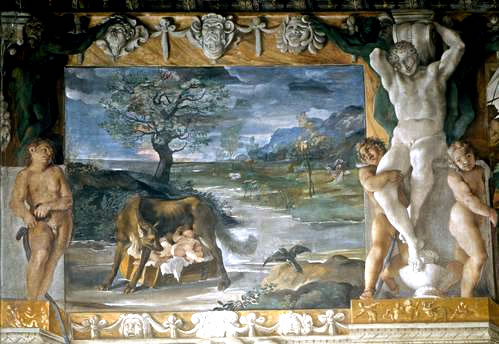Flooding of the Tiber

Livy narrates that in 189 BC the Tiber flooded Campus Martius twelve times, but the event was exceptional only in the number of episodes while it was normal for the Tiber to come out of its riverbed. The floods of the Tiber were a normal fact for Rome, as is also evidenced by the legend that places the flood of the river at the origin of its foundation transporting the basket of the twins Romulus and Remus and making it aground in the reeds in front of the Lupercal.
Tiber has never been a great river; its scope of 240mc/s is small when compared for example to that of the Seine (500 cubic meters) and the Rhine (2000 cubic meters), but in times of flood reaches tenfold. In the Bronze Age then, around the hills, various streams flowed into the great river, from the ancient Anio which flowed into the Tiber before Urbs, to the Almone the sacred river which, collected the waters that descended from Colli Albani and from springs along the lava flowing of Capo di Bove threw itself into the Tiber after the ford of the Tiber Island; then there were a number of streams that collected the waters of Palus Caprae and the sources and ponds that are located on the right bank of the river.
Another element that influenced the possibility of floods was the altitude of the valley in which the river flowed. In pre-Roman times, the altitude of the alluvial plain of the Tiber was between 8 and 10 meters above sea level, while today, due to the accumulation of landfills, it is between 15 and 20 m above sea level; one more rainy season was enough and the plain was flooding. Cicero in one of his epistles asked his brother about Ambulatio Crassipedes, a path in the beautiful property of the ex-son-in-law Crassipedes located outside Porta Capena and that in 54 BC it had been canceled by a particularly rainy autumn in which the Tiber had covered the entire valley of the Circus Maximus. The flood, which remained in the memory of Rome, was thus described by Cassius Dio in “Roman History”:
Just at that time the Tiber or because of the abundant rain that fell a little north of Rome or because or of the strong wind blowing from the sea pushed back its current or more likely by the will of some god, as was suspected, at the suddenly it overflowed with such violence that it flooded all the low places of the city and reached many of the highest places. The walls of the houses, which were made of bricks, were drenched with water and fell, and all the beasts died drowned. All the men who did not have time to take refuge on high places, died.
The history of Rome is, in some way, also the history of the catastrophic floods that hit it. In the Republican age there were numerous floods: in 414, 316, 241 followed by two in 215 and 216 BC. and then a particularly rainy period in which Rome was submerged in water in the years 203, 202, 193, 192, 191, 189 BC. and again in 60 and 54 BC and then again in the year of Julius Caesar's death, 44 BC; of these floods the worst was that of 192; in some years they have been fuller: 2 full in 215 BC. up to 12 floods in 189 BC remembered by Titus Livius ...
Sign up and read the rest of the article!
by M.L. ©ALL RIGHTS RESERVED (Ed 1.0 - 23/06/2020)







Bibliography: